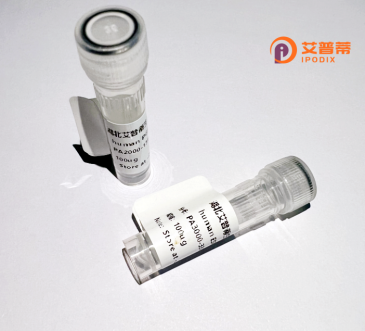
| 纯度 | >90%SDS-PAGE. |
| 种属 | Human |
| 靶点 | CD151 |
| Uniprot No | P48509 |
| 内毒素 | < 0.01EU/μg |
| 表达宿主 | E.coli |
| 表达区间 | 1-253aa |
| 氨基酸序列 | MGEFNEKKTTCGTVCLKYLLFTYNCCFWLAGLAVMAVGIWTLALKSDYISLLASGTYLATAYILVVAGTVVMVTGVLGCCATFKERRNLLRLYFILLLIIFLLEIIAGILAYAYYQQLNTELKENLKDTMTKRYHQPGHEAVTSAVDQLQQEFHCCGSNNSQDWRDSEWIRSQEAGGRVVPDSCCKTVVALCGQRDHASNIYKVEGGCITKLETFIQEHLRVIGAVGIGIACVQVFGMIFTCCLYRSLKLEHY |
| 分子量 | 28.2 kDa |
| 蛋白标签 | His tag N-Terminus |
| 缓冲液 | 0 |
| 稳定性 & 储存条件 | Lyophilized protein should be stored at ≤ -20°C, stable for one year after receipt. Reconstituted protein solution can be stored at 2-8°C for 2-7 days. Aliquots of reconstituted samples are stable at ≤ -20°C for 3 months. |
| 复溶 | Always centrifuge tubes before opening.Do not mix by vortex or pipetting. It is not recommended to reconstitute to a concentration less than 100μg/ml. Dissolve the lyophilized protein in distilled water. Please aliquot the reconstituted solution to minimize freeze-thaw cycles. |
以下是关于重组人CD151蛋白的3-4条参考文献的简要概括:
1. **"CD151 regulates tumor metastasis via integrin-dependent cell migration"**
- **作者**: Shiomi T, et al.
- **摘要**: 研究揭示CD151通过与整合素(如α3β1和α6β4)相互作用,调控肿瘤细胞的迁移和转移能力,重组CD151蛋白的实验显示其在促进癌细胞侵袭中的作用。
2. **"Recombinant expression and functional characterization of human CD151 in endothelial cell adhesion"**
- **作者**: Zhang X, et al.
- **摘要**: 报道了重组CD151蛋白在哺乳动物细胞中的表达和纯化方法,证明其在调节内皮细胞黏附和血管生成中的关键功能。
3. **"CD151 as a virus entry modulator: Role in HCV infection"**
- **作者**: Pileri P, et al.
- **摘要**: 研究利用重组CD151蛋白发现其作为丙型肝炎病毒(HCV)进入宿主细胞的辅助受体,影响病毒入侵的分子机制。
4. **"Structural basis of tetraspanin CD151-integrin interaction and its role in cell signaling"**
- **作者**: Hasegawa M, et al.
- **摘要**: 通过重组CD151蛋白的晶体结构分析,揭示了其与整合素结合的分子界面,阐明了CD151在细胞信号转导中的结构基础。
以上文献涵盖了CD151在肿瘤转移、病毒感染、细胞黏附和结构功能等方向的研究。如需具体刊物名称或年份,可进一步补充信息。
CD151. a member of the transmembrane tetraspanin protein family, plays critical roles in cell adhesion, migration, and signal transduction by organizing membrane protein complexes. It interacts with integrins (e.g., α3β1. α6β1) and other tetraspanins to regulate cellular processes like tissue morphogenesis, immune response, and tumor progression. Structurally, CD151 contains two extracellular loops that mediate protein-protein interactions and facilitate its association with laminin-binding integrins to form functional adhesion platforms.
In physiological contexts, CD151 is highly expressed in epithelial, endothelial, and hematopoietic cells, contributing to tissue integrity, angiogenesis, and platelet function. Pathologically, it is implicated in cancer metastasis by promoting cell invasion, protease secretion, and vascularization. Studies link CD151 overexpression to poor prognosis in cancers like breast, lung, and colon. Additionally, CD151 participates in viral infections (e.g., HIV, HCV) by aiding viral entry or spread.
Recombinant human CD151 protein, produced via mammalian or bacterial expression systems, retains its native structure and is widely used to study molecular interactions, screen therapeutic antibodies, and model diseases. Its applications extend to investigating mechanisms of integrin-mediated signaling, immune modulation, and tumor microenvironment regulation. Research on CD151-targeted therapies, including blocking antibodies or gene editing, holds promise for cancer treatment and anti-metastatic strategies.
×